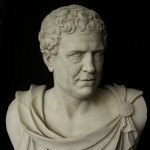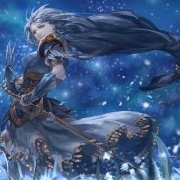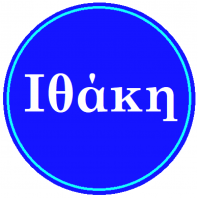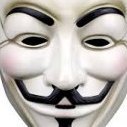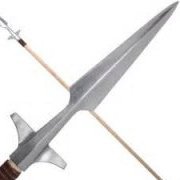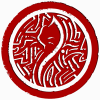Search the Community
Showing results for tags 'desolations'.
-
At the end of Rhythm of War we saw that the chasmfiend helped the Listeners. In the prologue there were three colors of blood. Red and orange are human and singer, and violet is the color greatshell blood. What if there were chasmfiends that were killed with the original fused and they got turned into thunderclasts? If they are sapient then they theoretically could be turned into cognitive shadows.
- 6 replies
-
3
-
- theory
- desolations
-
(and 2 more)
Tagged with:
-
Ok, so SPOILER, SPOILER, SPOILER, don't read if you haven't finished the book. Everyone was extremely sad with another loss to Bridge Four, and the way it happened, heart wrenching. I imagine though, killing spren is going to be far harder than the fuse think because.... shard blade/shard shields. Now that the Radiants know about this, their spren just need to make sure they manifest in their shard blade form if someone is trying to stab them. Thinking of that made me take a deep breath. Side note, can someone explain to me how this will allow conservation of investiture to be maintained?
- 2 replies
-
- desolations
- killing fused
-
(and 1 more)
Tagged with:
-
What are the Thunderclasts? From Dalinar's flashbacks we see a Corrupted spren dive into the stone under the Purelake and afterwards a Thunderclast rises from the lakebed. In Thaylen City, Venli describes the Thunderclast as twisted Singers. Which one is it, are they Voidspren or are they like the Fused, once Singers but then changed by Odium?
- 10 replies
-
- thunderclast
- voidspren
-
(and 3 more)
Tagged with:
-
So am I correct is believing that we still do not have a conclusive answer on what ends a particular desolation. Obviously the Heralds returning to Braize is the true end but when do they decide that a desolation is won. The only thing I can think of is when they have "killed" all of the fused, but that doesn't make sense as it it implied by Kalak's prelude that desolations would end with a (often closely fought) final battle that the heralds could predict would be the final battle before hand. (shown by the heralds having a pre-set meeting place for after the battle to start the return to Braize) Given the powers of the fused it seems that even if they lost a battle they would be very easy for some of them to just fly off and hide preventing the end of the desolation. But if it is not the fused, then what is it? Tib
- 5 replies
-
2
-
- stormlight
- desolations
-
(and 2 more)
Tagged with:
-
I highly doubt I’m the first to propose this, but in the Prologue and in several flashbacks depicting Desolations, there are references to large piles of burning Kremlings. We know that the Aimians are not very common on Roshar, and so it would stand to reason that few would know much about them. So it would be easy to mistake a pile of Hoardlings as Kremlings, especially when they’re burning. Do we know if the Aimians fought in the Desolations? And if so then were they fighting alongside or against the humans?
-
Given how destructive the Desolations on Roshar are, why is Sel still habitable? Once Devotion and Dominion were splintered, there wouldn't have been any force opposing Odium. I used to think that Odium simply didn't have any interest in harming anybody below major Splinter/Herald/etc power level. But it seems from Oathbringer that I was wrong about the Desolations on Roshar in my old Recreance theory: But then, I was focusing only on Odium's goals: at that point, I was expecting the Voidbringer/Everstorm-influenced listeners to be pure puppets with no motivations of their own (like Ruin-controlled koloss/inquisitors in Mistborn). If the Desolations' threat to humanity in general comes from the listeners' own desire to get their planet back, Odium might still not care. But even so... Threnody is super messed up, and it doesn't seem like either Odium or Ambition Invested there. So why isn't Sel more damaged? It seems pretty Earthlike.
-
I was going to post in Stormlight forums initially, but some WoBs are mentioning worldhopping so I thought it safe to post here instead. I apologize for the vagueness that is about to follow, I'm not sure for a lot of things revolving around this theory, so try and consider this as a starting point for discussion and share knowledge. I’m also not sure if this has been discussed here before, and if yes please point me in the right direction. Apart from various discussions I've had the last few months about several of the following points, what incited this madness of a theory is this WoB about “the Heralds needing to leave for a Desolation to end, but not all of them have to.” But let me take things back, further back, before I bring you into it. [1 – Shadesmar / Roshar correlation] So I made this little image in order to possibly help with what I am imagining about Shadesmar. We know from the map that where land exists on Physical, it’s a sea of beads in Shadesmar. So from this, I am assuming that the heightmap of the land is inverted between the two Realms. The high points and mountains on Physical are deep parts in the sea of beads. The ground below sea level in the Physical is the dark sky in Shadesmar. And the air in the Physical is part of the ‘land’ in Shadesmar. [2 – The shapeshifting land] The Rosharan map looks like a Julian set, so this implies it is an ever-changing structure. This could be happening by the distribution of crem and the Highstorm cycles, magically shifting the ground from one shape to the next with the passage of time. Because we have in-book maps that persist for hundreds of years, I'm assuming this phenomenon takes thousands of years to make a huge difference and it’s not something our characters are ever going to witness firsthand (at least not the immortal ones). [3 – Shapeshifting Shadesmar?] What would be especially interesting to consider in such a scenario is the corresponding change happening in the Cognitive Realm as a result of this. It could mean that the sea parts of Shadesmar would be continuously shifting, changing shape, providing Cognitive land access to places that didn't have it before and removing that same access later. On the other hand, we know that Shadesmar is the access point to and from other planets, with WoBs stating that Worldhoppers could possibly 'step in between light years' of distance when traveling between planets through the Cognitive Realm. Assuming the first humans to arrive on Roshar did this while the Julia set was aligning in such a way to allow passage from Ashyn, this would mean that the Heralds lived in an age where Shadesmar's mystery and functionality was already explored. They would've probably known that if you traveled to ‘a moon patch' that represents a planet and explore it it would allow land to 'grow' on Shadesmar. [4 – Rosharan planets made of air] So to reach the topic of the thread, what if the 10 gas giants around Roshar are actually the Tranquiline Halls, the pathways to Damnation from where Odium's Desolations could be ‘walled off’? Since the air in Physical would translate to land in Shadesmar, could it be that by visiting a gas giant and exploring it, a huge wall of land would appear in Shadesmar, all of a sudden? Could it be that each Herald was supposed to 'go back' to each one of the gas giant planets, in order to 'create a wall’ on the Shadesmar side, that would protect Roshar from Odium’s influence? Could it be that the Heralds were continuously tortured and killed in order to make them forget that part and the walls in Shadesmar to break down? Could it be that the Heralds eventually found out that not all of the ‘walls’ were needed in order to shield Roshar? That Odium only arrived from one direction in Shadesmar, one planet, and by leaving that one Herald corresponding to that wall, it was enough?
- 13 replies
-
- desolations
- rosharan system
-
(and 2 more)
Tagged with:
-
Hi, I just signed up to this forum, so this is my first post. Therefore, if there's another topic about this, please redirect me. Thanks! I finished my 1° reading of Oathbringer llst week, and I was just wondering: If the greatest impediment for Team Voidbringer during the desolations was the trapping on Braize of the fallen fused, then why didn't Odium sought to create the everstorm before, thus enabling multiple resurrections for the fused, many desolations ago? I'm looking forward to your opinions on the subject!
- 34 replies
-
1
-
- oathbringer
- odium
-
(and 1 more)
Tagged with:
-
So, in Oathbringer, we found out that Humans were the original Voidbringers. We also found out that modren Voidbringers are led by the Fused -- Ancient spirits of past Singers given great power by Odium taking control of a modren Parsh body. We know that the Oathpact was formed to keep the Parshspren imprisoned on Braize.. This means that the history of the Desolations is as such: Humans came with Odium to Roshar. They are given Shinovar to inhabit. --Girl Who Looked Up-- Humans have begun to spread beyond the bounds of Shinovar, and are violently taking land. The First of Desolations. --Odium offers some deceased Singers great power, and they accepted-- The Parsh have begun to side with Odium, as opposed to Honour and Cultivation. --Oathpact formed with Honour and the Ten Heralds-- Humans have now sided with Honour, and the cycle of Desolations has begun. Somewhere in here, Spren begin to mimic the Honourblades and bond with Humans -- It is unknown how Binding worked before this. --Aharietiam happens-- The Heralds, all but Talenel, have given up. The Oathpact is being maintained by a single Herald. The Knights Radiant stand guard over Humanity, and protect it from the False Desolation. --The Knights Radiant trap Ba-Ado-Mishram, ending the Forms of the Singers. The Recreance happens-- Many years later, Words of Radiance happens. The True Desolation has begun.
- 4 replies
-
4
-
- oathbringer
- desolations
-
(and 1 more)
Tagged with:
-
So, Oathbringer has quite a few references to the Sleepless. The one that has stood out the most to me has to be from page 438, during Dalinar's vision of Aharietiam, we get: Now, this has multiple implications. 1. Tighter Aimian - Human relations than what we see in modern day. The Aimian actively opposed Odium's encroaching forces. 2. Something has occurred since Aharietiam that has caused the Sleepless to avoid open communication with humanity. Likely related to the disaster said to have scoured Aimia of most of it's people. Thoughts?
-
So, this is a very theoretical post. It's not mega-sourced (which I hope is ok), because it's more about how we look at larger, more abstract concepts related to language and literary themes. I don't believe there are any spoilers here. Here goes. As I’ve been thinking about SA’s language, I’ve realized that a lot of the terms it uses sound like they could be part of a standard fantasy series with stock villains who have generic goals. We often take them for granted. But we see in some of the archaic meanings of words in in-world songs and texts, the terms can be opaque or have a second, often older meaning. Sanderson has had some fun with misunderstood words in other series, too... This led me to try a linguistic analysis of SA’s in-world terminology and to contextualize it with some of the major thematic elements of the series. Major Themes: Loss, Corruption, Recovery of Knowledge The Integrity, Durability (or Fragility) of Bonds, Barriers, Seals, and Oaths Terminology: I, and perhaps others, have been thinking about “Desolation” in terms of a goal of essentially sending Rosharans “back to the stone age” and wiping out civilization. It’s a familiar goal in an ordinary fantasy series. Additionally, because of the theme of the loss and gain of knowledge, this makes even more sense to the reader in the early stages of the series. But “Desolation” can also mean forsaken or abandoned (the Latin root). The word “Void” also sounds like it would be a cliché end-goal of a “big bad” in a fantasy novel. More like emptiness, the void of space, etc. But “Void” also means the breaking of a contract or agreement, or even a hole or breach in a wall meant to shelter or protect. What I’m suspecting, is that these terms—and their compound and modified forms—are interconnected. Some of these connections are familiar, but I think that they are much more complex and work on more levels than we realize. I’ve thought of a few ways that these terms apply to the series, but I imagine there are many more. This is in no way comprehensive. It’s more about looking at the series through a lens that I suspect the author uses. Here are a few: Shards and their goals: Odium is the “Broken One.” He breaks bonds, vows, oaths, he renders them void. He shatters. What helps the Broken One break/void pacts and oaths? Voidbringers and the Unmade. Honor is the shard most associated with oaths, bonds, fulfilling/adhering etc. He creates walls to protect, walls made out of humans, spren, and oaths. Here, we see the root of their opposing interests. Stormlight, bonds, and cracks: We know that Honorblades let too much stormlight in, perhaps making the user more susceptible to malicious influences. Knights Radiant, too, have cracks, but the symbiosis of the Nahel bond protects in most cases. And Voidbringers (whoever/whatever they are) are perhaps the “Knights Radiant” of Odium, though without patterns, laws, and can include species that have an affiliation with gems, stone, or are actual stones. They are able to hold in stormlight because Odium’s influence has corrupted them, sealing the cracks to only his influence, and making them like stone. Misunderstanding the purposes of Stonewards and “Dustbringers”: I suspect that Stonewards, in particular, have become confused in popular understanding, at least in the past. They may be strong like stone, but more important, they guard and protect against things made of stone or like stone/rock. They “ward” against stone-like bonded Voidspren. “Releasers” or “Dustbringers” may turn animated stone enemies, perhaps even VoidListeners, to Dust, releasing—and hopefully destroying—the bonded Voidspren. Part of the reason they are feared, even though they are needed, is because they break bonds, not unlike the Broken One and his friends. An example of language and double meanings from the Listeners: Conclusion: Perhaps the conflict, at least for the first 5 books, is about Odium’s attempt to shatter bonds, pacts, and oaths, layers upon layers of these protective forces that put up a barrier between Roshar and Odium. Should Odium render these protective bonds void, perhaps weakening them with the help of a loss of knowledge about the larger conflict and the less abstract assistance of the Unmade and Voidbringers, he will break through and fully touch Roshar and destroy its shard and cognitive shadow shard. The True Desolation involves a final forsaking or abandoning of the vows and bonds that protect Roshar and the more literal, catastrophic abandoning of its inhabitants, by shards, heralds, and others sworn to protect Roshar from Odium’s influence. This may not all be new, but I think that really digging into words that Sanderson chose for very specific reasons could lead to some fun ideas...
- 4 replies
-
7
-
- desolations
- voidbringers
-
(and 6 more)
Tagged with:
-
Some things we know: Honor was shattered a long time ago. Honor was shattered by Odium Odium is not in support of anybody being happy The Heralds in the prelude really do not want to go back to the place they go between desolations There is a quote in the prelude that mentions hooks and fire in damnation Honor likes the Heralds Some things I am extrapolating: There have probably been desolations before the shattering of Honor There have probably been desolations after the shattering of Honor Fire could be a natural phenomenon, but for there to be hooks in damnation makes it seem like an intentional torture planet Odium probably is happy about the Heralds suffering My theory There was probably some form of Damnation before Honor was shattered, but it wasn't that bad. Then, after Odium shattered Honor, Honor was no longer there to protect the Heralds, and Odium was free to make Damnation as terrible as it could possibly be. He can do whatever he wants to it because he owns Braize. Ideas?
- 4 replies
-
- honor
- desolations
-
(and 2 more)
Tagged with:
-
So I was reading through WoK again and I was struck by something I have never heard anyone discuss. So maybe it's nothing. Anyway, on Kaladin's first bridge run he is encouraged by a nameless bridgeman who, during the plateau assault, refers to Talenelat as "bearer of all agonies." The nameless bridge man dies shortly after, and Kaladin takes his padded vest and sandals. My question/thought is: how would anyone know to call the Herald of War by this title? Is it referring to his torture in Damnation, or just his role/function as a Herald? And if so, was it common knowledge that the Heralds returned to Damnation between Desolations? And if so, since the previous Desolation was the "last" one, why would anyone think that a Herald would return there? After all, aren't they all supposedly fighting to retake the Tranquiline Halls from the Voidbringers? I have a suspicion that this nameless bridgeman either knew something he shouldn't, or was someone special. If he was someone special, (like a HERALD!!!!) is he really dead? And if so, are there any unforeseen consequences due to his death? Or is this all just a meaningless tangent?
-
I have seen some references to this in other posts, but I have not yet found any answer or deep discussion on this... So, my main question is why/how did Taln resist in Damnation for 4500 years this time? The common answer is about his stubbornness, but I think that make no sense. Previously, ALL the heralds were in Damnation. Previously, Taln was in Damnation? Previously, the Desolations happen only hundreds of years apart. Now, when only one the heralds went to Damnation, it resisted for much longer?? Something is not quite right where... Some ideas: I have seen the suggestion that Odium plan for it. More time between Desolations mean more time for Humanity to forget how to deal with them (I don't know how to link to that post). Make sense, but then why chose a situation in which all other 9 Heralds are free?! Would it be better for Odium if all/most of them are trapped and only arrive on Roshar close to the Final Desolation? By allowing them to stay in Roshar it was possible for them to organize/teach people how to fight in the Desolation... As a side point, why the hell none of the Heralds did this?!?! I realize that they brook their oath. They might even be weaker (see Nale) because of it. But why did they completely abandon humanity? One of them at least should have kept teaching how to fight in the next desolation... Is it possible that the lie about Knights Radiant bringing Desolations was the reason for the Recreance? And it's not a complete lie and indeed the presence of many KR somehow bring the Desolations closer? Maybe this is why the gap was much larger (small number of KR in Roshar). The logic might be that KR use power from Honor/Cultivation. This weaken the grip of the prison for Odium and allow for the Desolation to happen. Maybe this was why the KR brook their oats! I saw the theory that the next Desolation starts when the FIRST Herald fail to endure the torture in Damnation (I always thought it would be when the LAST Herald fail). This would work for the time problem (Taln endure much more than any of the others). However, by rereading the prologue of TWoK this does not seem to be the believe of the Heralds. Related: - Why did KR start appearing close to a Desolation? What defines someone as potential KR and what decides whether the person will really be a KR? As conclusion, I think there might be something we are misinterpreting regarding Desolations/Oathpact/KR/Heralds. When things don't add up with Brandon, that indicates he is playing with us
- 12 replies
-
- taln
- desolations
-
(and 1 more)
Tagged with:
-
So after listening to Eshonai's interludes, I want to throw an idea out for discussion: The voidbringers are the Unmade. They are counterparts of the Heralds. Honor originally chose the 10 Heralds and gave them 10 invested weapons, splinters, we call the Honorblades. Spren saw this and mimicked it, creating surgebinders (the Knights Radiant) via the Nahel Bond. Odium originally splintered himself into the Unmade and gave them power that we do not yet understand. It is likely that there are 9 Unmade, as Braize (where Odium is) is 9-centric in contrast to the 10-centric cultures of Roshar (where Honor was). Spren saw this and mimicked it, creating what mankind refers to as "voidbringers," but are really things like thunderclasts and the stormform Parshendi. After all, the Parshendi obtain powers by bonding with spren, transforming them into something different, similar yet not the same as how spren bond with the surgebinding Knights Radiant. So the original battle between Honor's Heralds and Odium's Unmade became more intense as spren added men (and Parshendi) to both sides of the conflict, though this seems like an unintended occurrence by both Honor and Odium. Desolations became worse and more frequent as the spren (and the inhabitants of Roshar) became more involved. Eshonai fears bringing their gods back by using the ancient powers, gods she refers to as the Unmade (WoR). The Parshendi are determined to bring back the ancient powers to combat humans, especially because they see the humans have their ancient powers of surgebinding again. They fear the reprocusions of the Unmades' return (possibly because they, the "last legion," abandoned the Unmade by refusing to fight in the distant past). They know they will lose control as the Unmade possess them (in a way) and use them against their will. It's like the presence of too much of Honor's investiture (i.e. the Heralds, surgebinding) triggers the release of Odium's investiture (i.e. the Unmade, the "ancient power spren" of the Parshendi). In the past, Honor was able to regulate how quickly men were able to rise through the oaths and take on more of his investiture, which perhaps slowed the return of Odium and his agents. It's possible that this is what Nale fears - that men will too quickly summon Honor's investiture, which would trigger another Desolation. Perhaps this is what triggered the Recreance, that men chose to abandon the investiture of Honor in hopes of preventing the scale from tipping enough to open the gateway for Odium's return. Questions Still Unanswered How would this conflict end? The Heralds and Unmade return to their place (whatever torture they endure between desolations)? How? Did Honor and Odium agree that if one side won, that the game board (Roshar) would be reset? What does it mean to win a desolation? Since only 1 Herald returned to torture, how did the other 9 Heralds manage to keep the balance of investiture steady? The 9 abandoned their Honorblades, so does this mean they lost their connection with Honor? Did all of the Unmade return to torture (or their parallel place) at the end of the last desolation? It seems that at least one is still active (or recently became active) in Alethkar (i.e. The Thrill) and another is influencing the Death Rattles. Is Braize 9-centric because 9 Heralds stayed on Roshar or was this an original condition of Honor and Odium's arraignment? Where does Cultivation fit into any of this? What are your thoughts?
- 16 replies
-
4
-
- unmade
- voidbringers
-
(and 2 more)
Tagged with:
-

theory Voidbringers, the Knights Radiant, and Gavilar
DrakeMarshall posted a topic in Cosmere Discussion
So I have been re-reading WoR and have noticed something perhaps significant. So it is time for my first theory. After a few Sanderson novels, I have come to expect initial impressions and suspicions to be reversed. Who/whatever you think is the antagonist at the beginning never ends up as such. For example (beware of spoilers): -Treledees -Denth and Vasher -Preservation -The Lord Ruler (I would still say he was evil but he was not what you thought) I could probably go on. The point has been made, however, thus I won't. There is probably a similar reversal down the pipe in the Stormlight Archive. Starting with odium. I think it is fairly clear that odium is evil. Storms, he is the shard of hatred! Also, Hoid has a very poor opinion of Rayse, which probably does count for something. However, there is something else of note down this vein in the Stormlight Archive, linked to all these secret societies. We know that Gavilar was assassinated because he approached the Parshendi wishing to bring back the voidbringers. We also know that Taravangian loosely aligned with Gavilar. We also know that both of these people at least started out wishing to save the world, but it looks like what they actually tried to do was quite destructive. We also know that Ameram was interested in bringing back the voidbringers. And the ghostbloods are embroiled in all of this but we have no idea what they are looking for. So lots of people are interested in either bringing back the voidbringers or averting their return. I also want to highlight the "cover synopsis" of the Way of Kings: From the above information, I feel we can conclude two things: 1. The presence of radiants is associated with the desolations. Correctly or incorrectly, many presume a causal relationship between the return of voidbringers and the return of radiants. It would be interesting if this assumption was in fact correct. 2. The fact that both voidbringers and radiants have disappeared is not necessarily a good thing. So in light of this, Gavilar's efforts, one way or another, may have actually be saving Roshar. He tells Dalinar to "find the most important words a man can say" which probably means the radiant oaths. He tries to return the voidbringers, but this may actually be an attempt to restore the radiants as well. However, Gavilar foretells the approach of the everstorm to Taravangian. It even seems that all of his efforts are to prepare for the everstorm. So why would he be trying to bring back voidbringers? Wouldn't he realize that the voidbringers would cause the everstorm? It is possible he did not. Or perhaps the everstorm would have come eventually even if Eshonai hadn't caused it. Then there is also the motives of the society Ameram is a member of. We don't know very much about those other than that Ameram wants the voidbringers to return. I am inclined to believe Ameram's motives are not good, based on what he did to Kaladin. And there is the ghostbloods, which contains worldhoppers. The presence of worldhoppers implies that their motives are connected to the actual struggle between shards of adolnasium, something I doubt the others are keenly aware of or embroiled in. However, their motives are as of yet an enigma. All that being said, this theory doesn't really have a resounding conclusion. On the contrary, I am really making the point that we are probably wrong about a lot. Nevertheless, in conclusion: The return of the voidbringers means more than we think it does. Given that multiple groups are competing to return the voidbringers, there is probably some benefit to be had for whoever first creates voidbringers. However, restoring the voidbringers might not be as insane of an idea as we think. Gavilar might actually have been saving Roshar.- 47 replies
-
5
-
- roshar
- knights radiant
-
(and 3 more)
Tagged with:
-
I’ve been touting the “investiture imbalance” theory of Desolations. Please read that post for the theory. I cited Nale’s desire to kill surgebinders as evidence, since surgebinding IMO breaks down Stormlight into its three constituent investitures, though only using Honor’s and Cultivation’s. Surgebinding thus frees Odium’s unused investiture, creating the investiture imbalance that can cause a Desolation. I now posit that the KR’s discovery of this fact caused the Recreance. Recreance theories have run aground on the question: what would lead every KR to “kill” his/her spren simultaneously? I think knowledge that surgebinding could cause a Desolation would suffice. Perhaps Nale told the Orders what they were doing. Forum consensus favors the theory that Skybreakers were the Order that used “great subterfuge” to secrete themselves. They would be the one Order that could maintain the discipline not to surgebind. Thanks, as always, for any responses and comments!
-
Honor’s exhortation to Dalinar to “Unite Them!” has many meanings. Unite the Knights, Unite Roshar’s peoples, etc. (Honor is the “binding” Shard.) The natural question is what will happen when that group IS “united”? I think the “them” to be united refers to the Heralds. The re-establishment of the KR will draw the Heralds to them. Why do I think the Heralds? Let’s look again at the WoK Chapter 9 Epigraph: “Ten people, with Shardblades alight, standing before a wall of black and white and red.” Though this refers to “Shardblades,” I think it really means Honorblades capable of consuming investiture. Herald unification enables them to combine all of their Surges and, perhaps together with the KR, re-form the “bonds that drive Roshar” (WoK Ars Arcanum). I envision the ten Heralds standing against the Voidbringers, Honorblades “alight,” sucking in vast amounts of investiture – and thereby stripping the Voidbringers of their Odiumspren. Violent Voidbringers will again become passive Parshendi, and the thunderclasts and Unmade will fall lifeless, their state before Odium invested in them. Unfortunately, the Honorblades consume ALL investiture. (See my theory of "investiture imbalance" as the cause of Desolations.) That means the Heralds’ souls and all spren, including the Radiantspren. Victory against Odium means the end of the spren. See ya, Syl! We barely knew ya…
- 1 reply
-
3
-
- spren
- desolations
-
(and 3 more)
Tagged with:
-
“[The Enemy] Will Not Remain Bound by This” My 200th post!!! Humor me and pretend it’s a good one! The post epigraph comes from the WoK Prelude. It’s Kalak’s response to Jezrien when hearing of the Heralds’ decision to stay on Roshar following the “Last Desolation” – Aharietam. This post addresses what I think the “enemy” (presumably Odium) did in response. Odium’s actions comport with my “investiture imbalance” theory of Desolations. Background My theory of Desolations has been controversial. I think Desolations arise from an imbalance of the investiture comprising Stormlight. I believe Stormlight is made from the investiture of each of Honor, Cultivation and Odium. The function of the Honorblades is to consume investiture and reconstitute it as Stormlight, ensuring Stormlight’s balance. That’s why the Honorblades are in the mountains east of Shinovar, to capture the Highstorms’ remaining investiture, recycle it, and keep Shinovar spren-free. One function of the Highstorms is to sweep this investiture towards the Honorblades. Evidence for the “investiture imbalance” theory comes from WoB and text: WoB: If the Heralds linger on Roshar after a Desolation, a new Desolation will commence. That’s because IMO the Heralds themselves are largely Honor’s investiture that disrupts the balance. Nale kills Surgebinders because surgebinding breaks down Stormlight into its constituent investitures. Surgebinding uses only Honor’s and/or Cultivation’s investiture, but not Odium’s. This break-down frees Odium’s unused investiture, creating an imbalance that can cause a Desolation. I believe the “Heralds” are actually the souls of the original Heralds encapsulated in each Honorblade and augmented by Honor’s investiture – spren now capable of bonding. This investiture may also give them their “special” abilities. When an investiture imbalance occurs, the Heralds’ souls/spren leave the Honorblades and attach themselves to the “Shamans.” [i think the Stone Shamans are that because Taln – the “Ancient of Stone” (the Diagram), the “Spren of Stone” (so-called by Nale, I believe) – was the Herald who “died.” IMO “Shamans” are the equivalent of squires to the Heralds.] The Heralds “return” to the Honorblades after a Desolation either because they’ve been killed in battle or because post-battle the Honorblades consumed the investiture within their bodies (killing them), along with other investiture. That’s how the Heralds maintain “immortality,” living most of eternity in the Honorblades. The Heralds’ “torture” was their Cognitive Realm reaction to the binding of Stormlight. Odium’s investiture rendered their souls as Cultivation’s regrew them. In the Cognitive Realm, the Heralds still thought themselves human, and cognitively experienced the Stormlight-binding process as “torture.” That’s all background, so you know my theory. I wanted to summarize it here to bring me to the point of this post. Theory After Aharietam, there are nine Heralds on Roshar. Each Herald consists of substantial Honor investiture. Yet investiture balance is necessary to fend off another immediate Desolation – something I believe the Heralds do not know. What did “the enemy” do in response? Odium kept the balance for 4,500 years, deliberately forestalling another Desolation until his scheme (the Everstorm) was ready for implementation. He did this by placing/leaving nine counterparts to the Heralds on Roshar – the mindful Unmade (as opposed to the mindless Unmade mentioned in the Diagram). (Please don’t raise the WoB that there are not equal numbers of Heralds and Unmade – I’m only saying nine of them stayed, however many there might be.) It’s possible that for most of the time since Aharietam, the Unmade did nothing, keeping their presence secret. We do know that the Thrill has been around at least since Dalinar and Sadeas were young men (perhaps 30-35 years ago?) and possibly much longer, so one of the Unmade had to be active by then. Many Forum posters believe the black sphere Gavilar gave Szeth was an Unmade. WoB tells us that there are a lot more spren now than before Honor’s death. Jasnah says they’ve sensed whatever changes are happening/coming – perhaps in reaction to the Unmade’s recent behavior. Those spren provided “cover” – matched the amount of investiture – for the 50,000 stormspren that Odium created to invade the listeners. There is less investiture in stormspren than in Radiantspren, explaining the numbers differential despite equal amounts of aggregate investiture: Stormspren are sentient only, not sapient like Radiantspren, and hold less investiture. They have greater impact per unit of investiture than Radiantspren do because of the aggressive nature of Odium’s investiture. (Look at Eshonai’s change for an example of that aggression.) IMO stormspren are windspren that Odium has hijacked. He only needs to find a “hole” in them to inject them with his investiture. Thus, stormspren are mostly Cultivation’s investiture with only a bit of the aggressive Odium investiture in them. At some point the Honorblades became “aware” of the imbalance caused by Odium’s investiture. That’s when Taln emerged thinking the Desolation was about to begin – when in fact the last one in many ways never ended.
-
I have little basis for this post, but it is, after all, a theory. So bear with me. I postulate that the Heralds are the cause of the Desolations. Roshar believed that the Heralds always came back in time to fight and lead humanity against a Desolation, but what if that Vorin belief is only partially based in truth? What if the reason that the Heralds always showed up in the brink of time to lead humanity in the face of an oncoming Desolation is because they knew about its oncoming because they caused it? We know that Brandon is a fan of having his Shard-gods (like Preservation and Ruin) make deals with each other to preserve life on their respective planets. What if Honor and Odium struck a similar agreement? Odium is full of hate and wants to destroy anything that isn't as miserable as he is (since misery loves company), and he is incredibly powerful. He can eventually overcome Honor and Cultivation, so Honor devises a plan to extend the life of Roshar--he strikes a deal with Odium. The deal could conceivably have taken place like this: Honor can't stop Odium from destroying life on Roshar, but he can limit Odium's influence in some way. The key to Odium's getting full access to the planet: the Oathpact. Honor and Odium agree to a deal (much like Ruin and Preservation), where Odium is allowed to vent his hate on Roshar, subject to Honor's terms. This is where Honor's nature comes into play, as he asks for 10 volunteers to hold the key to Roshar's future in their hands. These 10 people will hold Odium's access to Roshar in their honor. Honor and the Heralds are honor-bound to conform to the terms of the deal and give Odium a chance to destroy Roshar, so the Heralds go to Odium's stronghold to be tortured until their honor breaks and they grant Odium access to Roshar. Odium, however, is bound by the agreement to return the Heralds to Roshar so that they can resist him. This is why the Heralds always arrived before the Desolations--they broke and granted Odium access to cause the Desolations! I propose that whenever one Herald broke, all 10 Heralds were sent back to Roshar. That would explain why Taln, known as Stonesinew and possessing (I infer) the strongest will of the Heralds, was able to resist allowing another Desolation for 4500 years until the book. Without the other Heralds to break first, Taln could resist the torture he was subjected to up to his natural breaking point. This could explain why he said that "I have failed," when he arrived in Kholinar--his will broke and he was returned to Roshar according to the terms of the Oathpact with Honor and Odium to resist the Desolation. This theory of the Heralds themselves allowing the Desolations, that their honor and will was all that stood between Odium and Roshar, and the as-of-yet unrevealed provisions of the Oathpact is an interesting one. I'd like to hear your thoughts. I didn't word this well at all. I'm tired. Sue me.
-
I have this theory about the Oathpact and the reason for the torture of Heralds, the death of Honor, the reason for the Desolations, and the origin of Honorblades that I don't think anyone else has already stated. First, I'll start with a couple references from Mistborn: In Chapter 57 of Mistborn:HoA, Ruin says this: And throughout the book it's made clear that Preservation's sacrifice was only a temporary solution that caused him to give up his mind, but would eventually allow Ruin to escape his prison. Also, in chapter 81 of HoA, Vin was able to use the power of Preservation to push back against Ruin causing her divine body to tremble in pain and agony and eventually die. I know Vin didn't trap Ruin this way, but I'm just pointing out that she hindered Ruin and that fighting a god causes pain - at least when the gods are so opposed. To me, this sounds a lot like the Oathpact. It's called a bargain, instead of a pact, but they mean almost the same thing. There is pain involved. A god must give of themself. A god eventually dies as a result. A god is trapped/imprisoned or hindered in some way. It's a temporary solution. Now, what if Honor and the the Heralds figured out a way to trap (or at least hinder) Odium and make it closer to permanent? Instead of Honor suffering agony for thousands of years (just like Preservation), dieing, and Odium eventually escaping (or regaining full power), the Heralds agreed to endure the pain in place of Honor (how this was accomplished will be discussed below). And what if by doing so, they prevented/delayed Honor's death? There was some kind of bargain (Oathpact) between Honor and Odium that trapped/hindered Odium temporarily, but caused Honor to die, after a few thousand years of agony, in the process. Afterall, would it not be honorable to give up your life to save the lives of the entire world? However, Odium was tricked because of the intervention of the Heralds (this might be considered dishonorable though, so Honor would not be involved in the trick). Odium still escaped his prison (or regained his full power) every few thousand years and it caused a Desolation. He is defeated and re-imprisoned; the Heralds return to the place of torment; and Honor still lives as a result. Now, I know Taln was still being tortured after the "last" Desolation, but what if that wasn't enough to save Honor's life this time, so he died or splintered. There is speculation that this is what caused the Recreance. Finally, I think this original Oathpact is what forged the Honorblades - their origin being hidden in plain sight. Honor had to give of himself to trap/hinder Odium, and the Honorblades are the physical manifestation of Honor's power - much like the Mist is the physical manifestation of Preservation's power or Atium is Ruin's. These Honorblades were given to the Heralds to grant them great power during the eventual escape of Odium. But in the process, because they held pieces of Honor's "body," they endured great torture when they were in the place of torment. I believe that place of torment is one and the same as Odium's prison. Holding an Honorblade and being in Odium's prison at the same time is excruciatingly painful, but it saved Honor's life - until the Heralds (except for Taln) failed to return the last time. Any thoughts, flaws, additions? Edit: modified for clarity and to address some of the comments below
- 12 replies
-
9
-
- cosmere
- preservation
- (and 9 more)
-
I was thinking about the scale of the Desolations. The Desolations were said to have the follow properties, chronogolistically: • There were apparently 99 Desolations • The Desolations last years, one as long as eleven • The Desolations destroyed 90% of the population • The Desolations often regressed a population back an era of technology or two (Iron Age to Stone) So, we know current Roshar is 4500 years since the last Desolation. Given the above facts, the minimum length we could expect the break between Desolations to take would be eleven years (assuming they do not overlap). More likely, we would expect them to have breaks of a several hundred years (in order to rebuild the population and to account for the loss of tech). That would mean, if there were 99, that the Desolations last for no less than 1100 years, and more likely somewhere between 20 000 and 100 000 years. That's just too long. My theory here is that - There were only nine Desolations, and that was distorted by history to become 99 (possibly through Vorin symmetry). Other than my gut feeling that people like Hoid and the Shards haven't been just sitting around derping for a hundred thousand years and then suddenly things got busy, I do have a little bit of evidence to support this claim. Supporting Points: (From myself and the many posters below!) In one of Dalinar's flashbacks, the time is referred to as the Eighth Epoch. At the time of the Eighth Epoch, there were Knights Radiant. We know from a certain slightly madman in Words of Radiance that the Knights Radiant were implemented late in the cycle of Desolations, long enough for the Heralds to become both used to and fed up of rebuilding society, but not so early that the Radiants were able to preserve enough knowledge to advance them past the Iron Age. This suggests that there were in fact, nine Desolations, with Dalinar's vision occurring during the eighth. The time between each Desolation was considered an 'Epoch'. With only nine desolations, even at 1000 years in between each Desolation, we only hit 9000 years. Which is a fairly acceptable number, comparatively. I say 1000 because, well, 10 is very Rosharan after all! The Desolations were devastating enough to reset the technology level an era, for example, from Iron Age to Bronze or Stone Age. This was revealed to us by the person called Taln in WoR, who mentions a number of things that indicates first hand knowledge of the Desolations. He also indicates that they have some time prior to the arrival of the Desolation. This means that each Desolation must take at least enough time between them to lose a tech level (normally takes a thousand years or so to tech up at that point in history - presumably not all knowledge would be lost so shorter than that). And the Desolations must be at least Devastating enough that it wouldn't be unusual for the entire world to lose a thousand years of technological progress - no mean feat, and probably entails huge damage to the population and infrastructure which they would need time to recover from. The idea of large gaps are supported by Taln's torture. "Taln" withstood 4500 years of torture at ten times the usual intensity. And at that point, Odium has had all the previous times between Desolations to develop his torturing abilities to their max. It would be insane if the Heralds can't withstand at least 450 years when Taln took on ten times that, in both duration and intensity. (PorridgeBrick) It's incredibly hard to rebuild when infrastructure is entirely gone. Consider the fall of Rome. After the Germanic tribes sacked everything, incredible amounts of technology were lost, some of it forever, and the Dark Ages started. The people at that time all knew of the technology that was possible: they'd been the ones using it, some of them building it. That knowledge wasn't passed on. There was neither the economy, governance, nor resources to supply using that technological knowledge. And in this sort of preindustrial society, knowledge is passed down by family lines or apprenticeship. Kill off a family, you kill off the secrets of their trade. In bad times, all you do is try to feed your family. You don't care about spreading your knowledge, preserving technology. Now, let's apply this to the Desolations. They'd literally just learned bronze-working. This wasn't all that widely known, presumably: there's only so much one man can do to teach an entire population in a small time span. And everything was just ruined. Their population has been ravaged. Their farms to supply food, their mines to supply metal, their men sent off to fight in the war, all are decimated. The Heralds can't exactly stay long: they can't risk sending another Desolation. These people are going to be desperate. They're not in the situation to technologically innovate, or even preserve. They're back in the Stone Age, hunter-gatherer societies. It takes time to regrow populations, to rebuild civilization. This again leans towards longer Desolation breaks. (PorridgeBrick) Brandon consistently offers unreliable in world information, and we know the Vorins tampered with historical texts and accounts in a variety of places. The unlikeliness of the Desolations lasting hundreds of thousands of years provides an indication that they may be one of those unreliable accounts. Roshar is full of the number 10. The True Desolation being the tenth Desolation would work very well. There is also probably more to the Heralds leaving at exactly the number they did (either 9th or 99th) than just 'they were tired'. Because 99 or 9 are both immediately prior to the number 10 (or ten tens). This is another indication that there is something more going on with the Desolation count and the Oathpact breaking than we are being told. The Vorins add symmetry to all sorts of things for kicks. Notably, the Herald's names all got symmetrified. Converting nine to ninety-nine to have a more symmetrically pleasing number is not outside the realm of possibility for a religious organization that wants to make everything symmetrical and is changing historical accounts to do so. Having the Desolations last hundreds of thousands of years is really too long. We know Adonalsium shattered, and that sometime after that Honor, Cultivation, and humans arrived on Roshar. In the meantime, Odium has been around, and Hoid has been doing things, and there was the seventeeth shard. Did those organizations and people really sit around and do nothing for 100k years and then all of the sudden, Hoid starts searching, Odium starts breaking other shards, and the 17th becomes active, all during the span of a couple thousand years? Seems unlikely. I'm not even sure the Heralds could stay sane after 100k years of torture. In Dalinar's vision in the chapter Starfall, where he talks with the two Radiants and fights the Midnight Essence, his 'wife' implies there hasn't been a Desolation in her life-time, which I'm assuming is ~30 years old. However, there's still some sort of legend or history regarding Desolations, so the memory hasn't faded completely--meaning to me that one has happened within the last 5 generations (150 years). Even if we assume that there's generally 100 years from the start of one Desolation until the start of the next, that's still a good ~10,000 years this has been going on. Tempus's argument that 100k years is too long for anyone to not do anything about it is very reasonable and nearly as applicable to a much smaller number (like 10-20k years) as well. (kaellok) One possibility for length - 4500 years since the last Desolation. 4500 is a perfect multiple of nine. 500 each. If this True Desolation is the tenth Desolation, well, what we're looking at here is another symbolic clue based off the Roshar love of ten, and could place each Desolation gap at 500 years. This is by no means a certain deduction, it could just be general symbolism and non-indicative, but were this to hold true, 99 Desolations would have been about fifty thousand years, but nine would be the nicely symmetrical 4500. It's not conclusive, but is another small shred to add to the symmetry and symbolic tens pile.
-
On a reread of Wok and Wor i noticed that i dont get the purpose of desolations; to express my thoughts i make this crude timeline: Age 1: Heralds are around, no Radiants, humankind gets stomped by voidbringers ( they partially dont even have bronze weapons, culture seems to change between stone age and bronze age); Nohadon writes his book after a stomping Age 2: Heralds are around; sprens form radiants, human military power multiplies ( shardblades, shardplate, use of stormlight); humankind still does badly, might ocassionally be trashed by voidbringers Age 3: Oathpact shattered, maybe some desolations afterwards ( in Dalinars visions there was this guy who was said to be able to accuratly predict desolations, so he had lived through some; i dont understand why one should start trying to predict desolations if the best sign was the appereance of the heralds, 100% accuracy in that, why bother predicting then?; except the heralds would have already abandoned the oathpact); day of recreance, radiants no more around If the desolations where there to eradicate human life on Roshar, why wasnt this accomplished in Age 1, when humankind was at its weakest ever? Do the voidbringers even care about killing all humans? Or is there some kind of wincounter like goals in soccer get counted and it was decided between Odium and Honor that the winner is who first get 100 won desolations, the looser gets shattered or whatever. While i think this whole fight between Odium and Honor was about shattering Honor, the current upcoming desolation makes no sense in this regard as Honor is already shattered. It might be that Preservation is the target now but i dont understand why she wasnt shattered together with Honor, they both seemed to have worked together, or not? All in all i have no idea whats up with these desolations Please help me get through this mess Thanks
-
“True Wit is Nature to advantage dress’d What oft was thought, but ne’er so well expressed” [ASIDE: In the Spirit of Sanderson, I thought I’d begin with an epigraph of my own, this one from Essay on Criticism, the 1709 poem by Alexander Pope. Unlike our Wit, Pope was a hunch-backed asthmatic dwarf. But, like Wit, Pope was the leading satirist of his time. His jibes earned him the enmity of many. Tupac and the Notorious B.I.G. were not the original “gangstas”; when Pope wandered the London streets at night, he took with him two loaded pistols and his two Great Danes (what an image!) You’ve all heard many of the lines from Essay on Criticism, but might not have known their source. Here are a few: “Fools rush in where angels fear to tread”; “A little learning is a dangerous thing”; “To err is human, to forgive, divine.” ASIDE OVER – thanks for reading this far!] On WoR’s last page, Wit says to Jasnah, “You’ll find God in the same place you’re going to find salvation from this mess…Inside the hearts of men.” Of similar import is this phrase from the epigraph to Chapter 71, from the Second Letter: “[Rayse] bears the weight of God’s own divine hatred, separated from the virtues that gave it context.” [Second aside: Does that mean the Second Letter writer considers Adonalsium to be God?] I believe these statements capture the theme of The Stormlight Archives, and perhaps all of the Cosmere novels: the importance of balance. Not necessarily of “harmony,” which assumes perfect equilibrium, but of balance, offsetting characteristics that temper the edges of each. The shattering of Adonalsium upset the balance of the Cosmere by giving primacy to specific aspects of Godhood: Honor, Hatred, Growth, Ruin, Preservation, etc. Maybe it’s the imbalance of each Shard holder that causes them to lose their humanity, since each Shardic Intent operates within them unopposed. I think Wit’s statement to Jasnah means that to defeat Odium, men’s hearts must return to honor – doing what’s right and not only what’s legal. That doesn’t mean that people won’t hate, but that hate cannot be allowed to dominate them – balance is necessary. Sadeas and Nalan appear to be character devices to illustrate what happens when imbalance captures the heart. Adolin may end up showing us balance despite his lapse. As I’ve said in other posts, Honor binds, Odium divides – centripetal and centrifugal forces. To find the place in the middle, they must be combined – not the harmony of Mistborn, but a complementary tension. I think the Battle of Champions in Book 5 will be fought by Kaladin and Eshonai (not Szeth, who is clearly unbalanced in every meaning of that word and will likely continue his story into the second five books). Halfway through her bonding with the stormspren, Eshonai tried to halt the process. This may have caused an imperfect bonding and may explain why the rhythms of peace still try to assert themselves within her. I predict that during the Battle of Champions, her desire for peace will defeat her desire for destruction. Eshonai and Kaladin together will form that unity, that bonding of honor, that will enable them to halt Odium’s gains – the Everstorm may or may not continue at that point, but Odium will be temporarily thwarted. In the second five books, he will seek another approach: hatred among men. Odium is already a long way towards reaching that goal (see Jah Keved and the wars in the West). One last observation: before WoR was released, I speculated on another post what Odium gains by the Desolations and the Everstorm. Based on the Second Letter, epigraph to Chapter 69, we now know that Odium is bound to the Rosharian planetary system: “Rayse is captive. He cannot leave the system he now inhabits. His destructive potential is, therefore, inhibited.” The natural inference is that he seeks to destroy Roshar to free himself from his bonds. The Second Letter writer further states (in the epigraph to Chapter 70) that this binding might have been by “Tanavast’s design.” One can envision that either the Oathpact or Tanavast’s splintering might have had the effect of causing Odium to be so bound. How interesting, then, that Hoid/Wit, who has “never been a force for equilibrium” and who “tow chaos behind [him] like a corpse dragged by one leg through the snow” (epigraph to Chapter 74) should be the one who seeks to re-establish equilibrium by focusing on “men’s hearts.” He may be (reluctantly) content to destroy humankind on Roshar if necessary to triumph over Odium, he tells Dalinar. But if humankind is to save itself, it must find balance within its own hearts.


